April / May 2014
Bali
Coming from the Philippines I started in Bali with the plan to travel from island to island jumping ever further eastwards. In the 80’s I crossed Sumatra, Java and Bali. Now I wanted to discover other islands.
Seminyak
A colleague of mine recommended as the first destination in Bali Seminyak, a more chic place on the coast of Bali. The hotel was good and with the fast internet I could plan my trip. But I didn’t like the place at all. Street noise and exhaust fumes made walking a torture. At the beach stinking brooks were winding towards the sea. A restaurant nearby was recommended by the Trip Advisor website. On the very first evening I ate there. It turned out that the restaurant was run by a Swiss. The food was gourmet and also the open wine was drinkable, a rarity in Southeast Asia. So I came regularly and was soon a colleague of the boss. Unfortunately, he could hardly give me any tips about Indonesia, as he had not seen much else from Indonesia except Bali. The Balinese are Hindu. The religion is omnipresent despite the many western influences in the life of a Balinese. Every village, but also every house has a temple. Also my Swiss colleague had to build a temple for his restaurant, because without a restaurant temple he could not have found any staff.
Ubud
Next I traveled to Ubud, an artist village in the interior of the island. Compared to 1988, the last time I was there, there was more traffic and the place had grown, but Ubud was able to keep its charm. I lived in a house that was part of a former palace and had a view over the rice fields from my terrace. Ubud has always been the artistic center of Bali. Painting, stone-masonry, wood carving, dance, puppet theater and architecture are practiced. Several museums show the masterpieces of local and foreign artists who lived in Ubud.
The Agung Rai Museum of Art (ARMA) is the best museum of Balinese art.
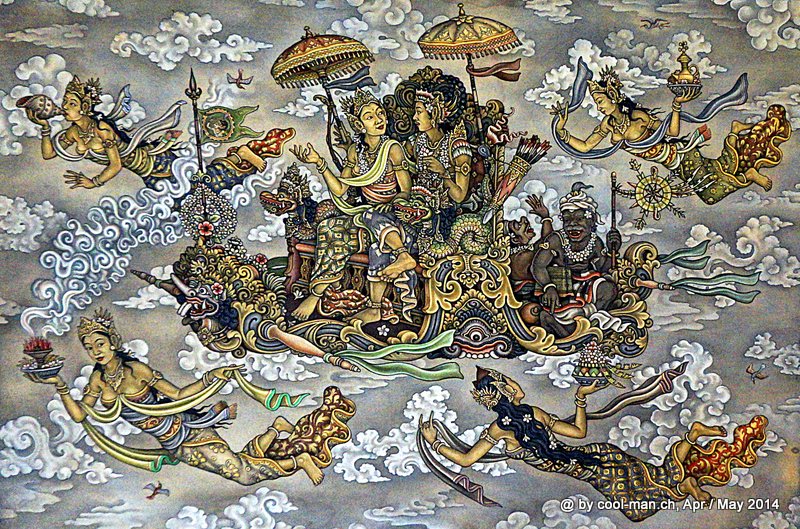
Two Balinese girls

In the evening Balinese dances are performed which are very worth seeing.
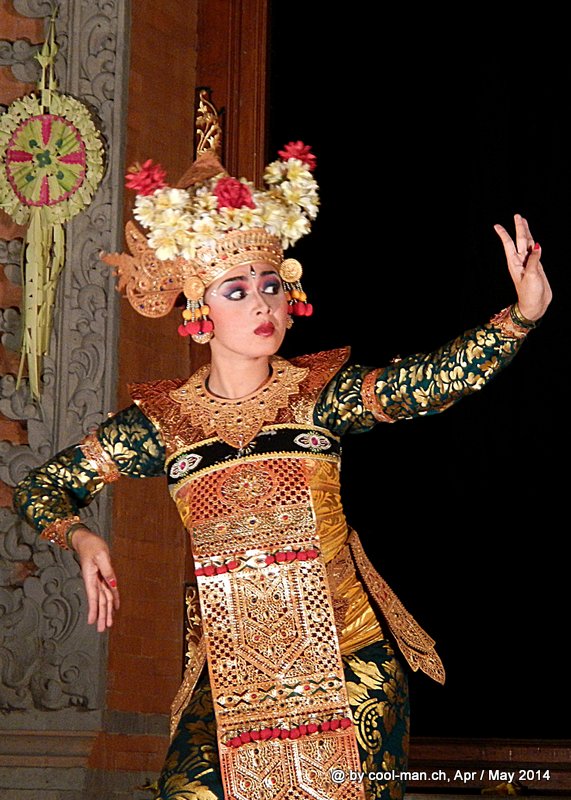
I enjoyed that thanks to the steady stream of tourists, some gourmet restaurants were opened in the meantime that offered Indonesian food with western influence on a high level. From Ubud I undertook some bicycle tours. The routes led past countless temples and rice fields. So sport is fun! A tour led over Kintamani, a beautiful area, where a volcano stands at a lake, which is part of a huge crater. In the 80s people did not like strangers there. If someone had spent the night there on a motorcycle tour, he had to expect that there was sugar in the fuel tank in the morning. Meanwhile many hotels were built around the lake. But even today tourists are treated unfriendly by the locals.
My next destination was the island of Lombok, where I visited the immigration office to extend my visa by another 30 days to 60 days.
Gili Trawangan
Afterwards I spent a few days on the small island Gili Trawangan, where you could see turtles while snorkeling and eat excellent food.
A Hawksbill Turtle

The next eastern island Sumbawa did not offer any sights according to the travel guide. So I booked a 4-day-3 night boat trip along the coast of Sumbawa from Lombok to Flores Island. I got one of the two cabins that the other passengers envied me. We saw a group of small whales on the way.
Laba Island
We stopped at a place near Laba island where Manta Rays are often seen. In fact we saw several of these big animals while snorkeling.

A Spotted Eagle Ray
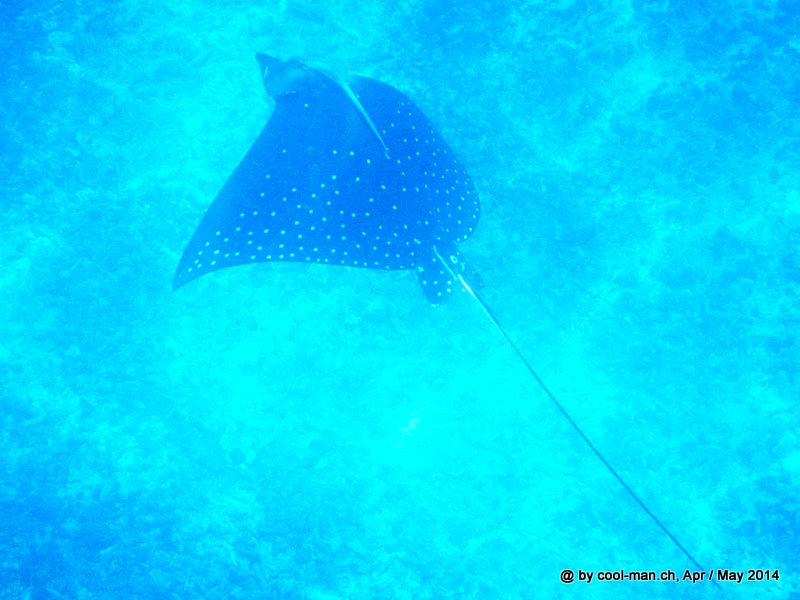
A Lined Surgeonfish
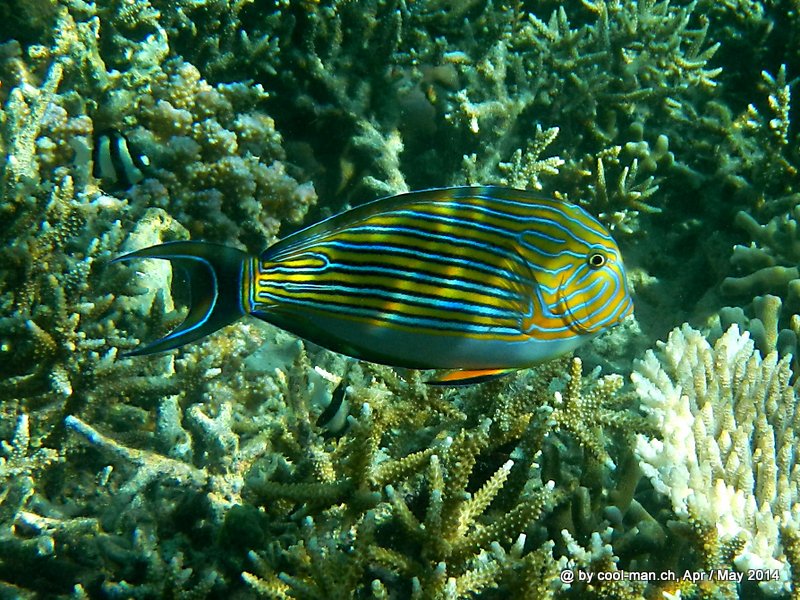
Komodo and Rinca Islands
As part of the tour program we visited the two islands Komodo and Rinca of the Komodo National Park. About 5’000 Komodo dragons live on these islands. They are the largest lizards in the world. They are perfectly adapted to their environment. They can run faster than humans and they can swim. The most dangerous thing about them is the bite. Their oral hygiene is so poor that a single bite is enough to kill even large animals like buffaloes. With the bite, bacteria and, as scientists have only recently discovered, a poison are transferred to the wound that the wound can no longer heal and the victim dies within a few days. The dragons only have to wait for their victims to die. If the victim is dead, the whole lizard family eats the prey. Bones are also digested. Pigs are devoured completely. A few weeks before my visit a ranger was bitten. He had to be flown to Bali immediately and treated so that he could survive. Thirty years ago, a Swiss man who was no longer with the group at the end of a guided group hike was less well off. His camera was found during the subsequent search operation.
The Komodo dragon can smell its prey and its direction with its tongue over a distance of up to 4 km. The sense of smell is more important than sight and hearing.

Isn’t he cute? I mean the dragon, of course.
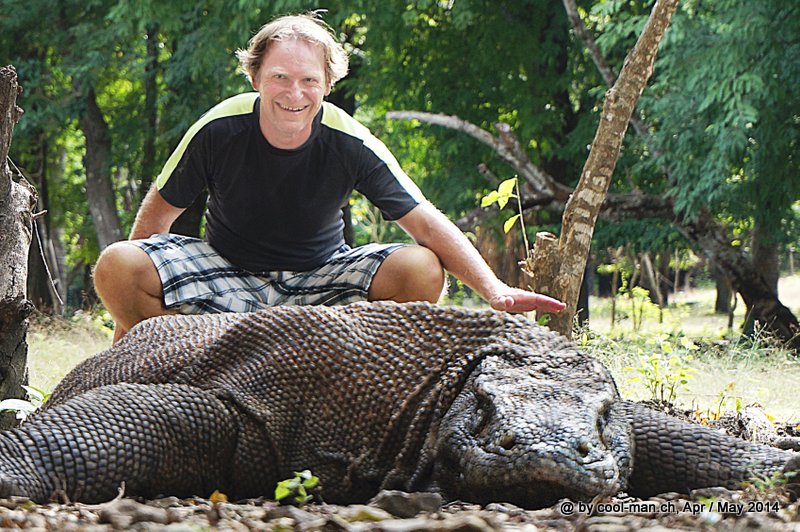
Kelor Island
Our boat (left) at the last stop on the boat tour between Lombok and Flores on the island of Kelor.
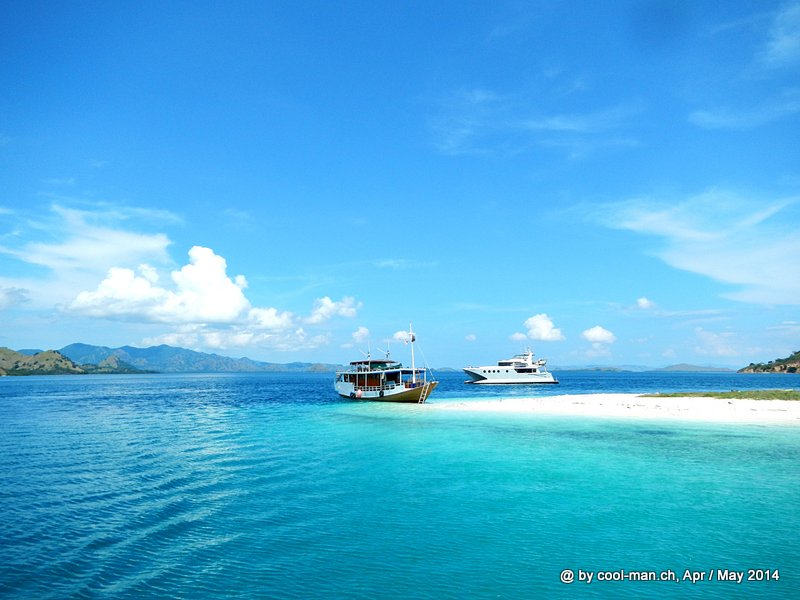
Flores Island
Labuan Bajo
At the end of our boat trip we reached the city of Labuan Bajo on the island of Flores. From this city the dive tours start to the waters in the Komodo National Park, which are considered to be one of the world’s best dive sites. Accordingly, there are tourists with purchasing power. It is a blessing for the city, as there are three Italian restaurants competing with each other. I stayed longer than planned, because dishes on the highest level like Barracuda Carpaccio, tender lamb chops on a herb crust, spaghetti with homemade pesto sauce, tiramisu and pizza like in the pizzeria at the Italian restaurant I did not have for a long time and I will not get it on my plate in Indonesia any more.
Bajawa
We were about thirty travelers on the boat and some had the same travel plans as me, so we traveled east in a small group on Flores Island. The next town on Flores was Bajawa. We hiked to a few traditional villages where people weaved and sold fabrics. Technical achievements like electricity, TV and a TV satellite dish were also found in a traditional village.
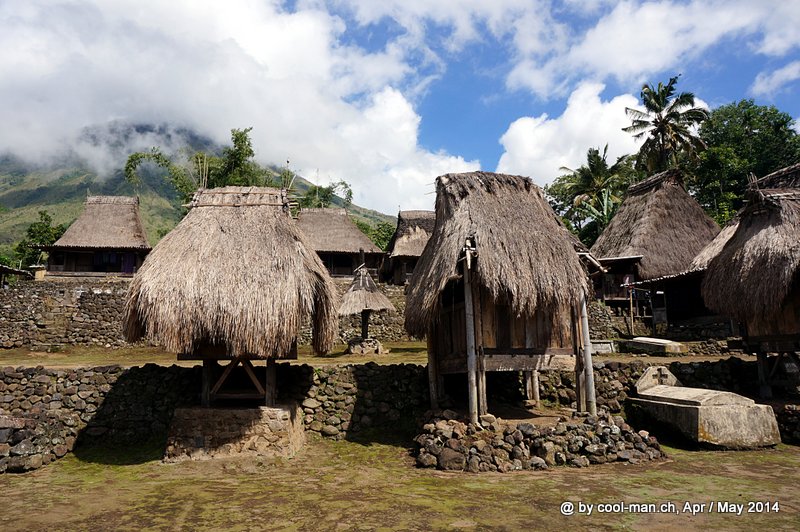
A woman chewing a betel nut
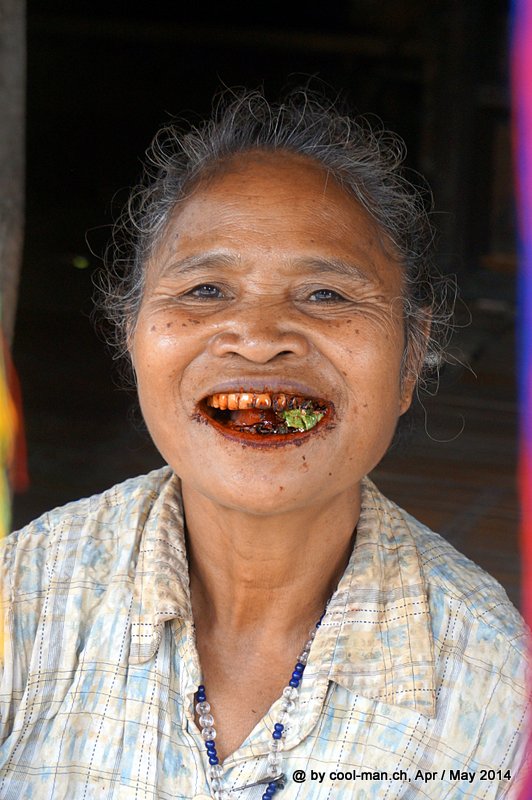
A hot spring heated up half of an entire river. After being in the hot part, you could cool down a few meters further on.
Volcano Inerie
The next day I climbed the volcano Inerie before sunrise. Had I known what was coming, I would have renounced it. You had to fight your way up through round stones, which started rolling very easily. I could have the torn trousers and shoes sewn at the Bajawa market. The countless wounds had healed again after one week. After all, one could enjoy a panoramic view of other volcanoes, hills and the sea from the summit.
Volcano Kelimuti
The bus journeys on Flores are a difficult matter. Sticky air, living animals, small seats and countless stops make the bus trips a topic of conversation among the travelers. All the more I was pleased when I heard that two tourist guides drove back a car empty after they had transported tourists in one direction. So, for the price of a bus ticket, I could comfortably reach the mountain village of Moni, eight hours away, in a new car with air conditioning and two friendly guides.
Thanks to the proximity to the volcano Kelimuti the travelers make a stop in this small village. The volcano is unique, as the volcano consists of three adjacent crater lakes, each with a different color. One lake is turquoise green, the other is rust red and the third consists of clear water.
Two of the three different colored crater lakes of the Kelimuti Volcano

The island of Flores was soon traversed and I didn’t know where I wanted to go next. The island of Timor seemed to offer few tourist highlights. A Swiss couple from the Lombok-Flores boat made my decision easier. They told me that the next day a ship was leaving for Sulawesi Island and that they had already bought tickets. After a short consultation with my guidebook it was clear that Sulawesi is an interesting island on which I could experience many interesting things in the remaining month until my return to Switzerland.
Sulawesi
The ship was a huge ferry of the state-owned shipping company Pelni. I thought I knew this kind of ferries from the Philippines. Usually they have a large air-conditioned hall with seats, where you can travel quite comfortably. Except in the cafe there were no seats at all and the ship was overloaded. All people spread out on the ground and settled in for the next eighteen hours until arrival. People were sweating and sitting and lying on the hard floor was uncomfortable. I had nothing to eat, which was a mistake, because there was only a pre-cooked menu to buy that didn’t taste good. An Indonesian neighbor traveled to Sulawesi to get married. A whole clan traveled with him. The women had precooked several menus and spread them out on the floor. The rice was wrapped in banana leaves. When the women saw my eyes, I was kindly invited. Finally we reached Makassar on Sulawesi at two in the night. Tired we went to the hotel and were glad to be able to lie soft and cool again. The ship trip was an experience that I will not forget so quickly. But next time I will fly.
Makassar
Makassar is the largest city of Sulawesi. You can shop in a large traditional market as well as in modern shopping centers. An interesting part of the city is the port, where the traditional ships of the Bugis seafaring people are loaded and unloaded. These ships have been traded for centuries.
Bira
According to my travel guidebook, Bira, eight hours away by bus, was worth a visit. I was disappointed. Bira is a weekend destination for the people of Makassar and these people leave behind a huge mountain of rubbish on Sunday evening. I arrived on Monday and regretted having chosen this detour. At least I was able to go on a full day snorkeling trip to other islands. The corals and fish were quite interesting, but I had expected more. Nearby there was a shipyard where the Bugis build the ships I had seen in Makassar harbor. It was impressive to see how the workers sawed the wooden parts in the right shape without having a written plan in front of them. These people have the whole construction plan and the shape of all the parts just in their heads!
Tempe Lake
Since the bus connection to my next destination, the Toraja country, was complicated and time-consuming, I appreciated that I could charter together with a German couple a car with driver, which brought us to Sangkeng with good bus connections to our destination. Since we arrived in the city in the early afternoon and planned to spend the night there, we took a trip on the huge Tempe lake. A few families live on houseboats on the lake and make a living from fishing and the aquatic plants that grow on the lake.
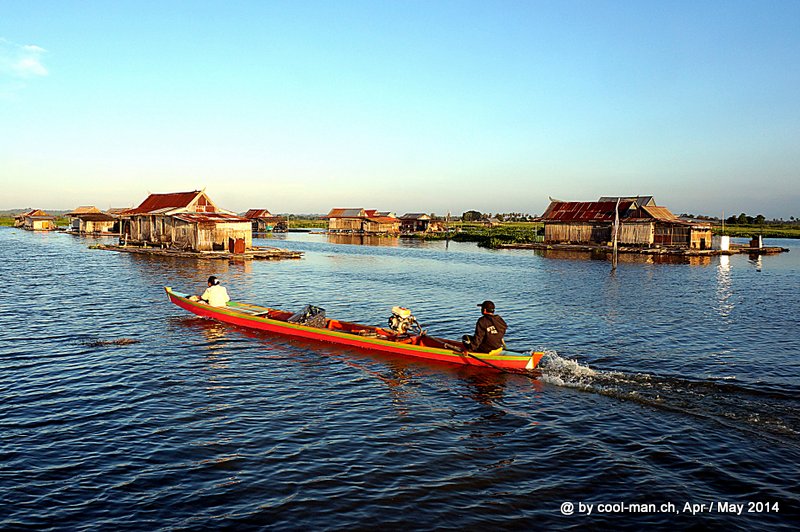
One of the ways to transport chickens on Sulawesi
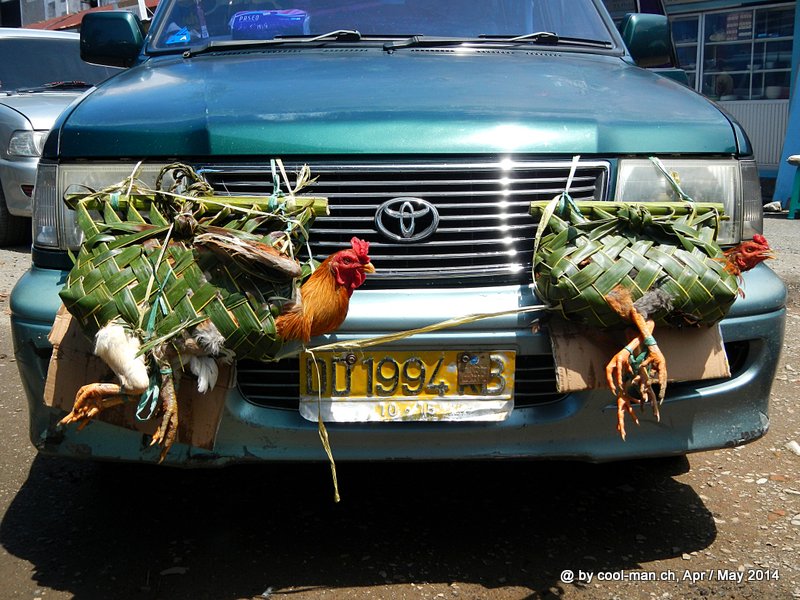
Ratenpao
The next day I travelled to Ratenpao, the capital of the Toraja land. This area is known for its ship-like roofs, which extend far in the front and in the back.
Toraja houses under construction

Opposite the dwelling house a somewhat smaller rice storage is built. The walls of the houses are richly decorated with wood carvings and countless buffalo antlers often line up vertically over the whole height of the houses.
Toraja Funeral
The main attraction of the area are the elaborate burials, which last several days and at which dozens of animals are slaughtered, mostly buffalos and pigs. The number of animals slaughtered indicates the status of the deceased and his family. The Torajans believe that the more animals the dead have at their disposal, the faster they will reach the afterlife. At the funeral ceremony, which I attended, about twenty buffaloes, thirty pigs and one foal were killed. The value of the animals was tens of thousands of US Dollars. No wonder, then, that they have to save up to two years after death until there is enough money for the funeral. Very rich people can afford to have an albino buffalo slaughtered. These animals cost up to 50,000 Us Dollars. I attended a medium-sized funeral. The meat of the slaughtered animals is distributed. The state and the church receive the first share. The remainder of the meat goes to the family and to the participants of the event, whereby the share depends on the reputation. The slaughtering takes place in front of all visitors.
A buffalo at a Toraja funeral in death agony

…and dead.

It’s perfectly normal for children to see the killings. They then get the cut off buffalo feet to play with.
The buffalo feet are for the children to play with.
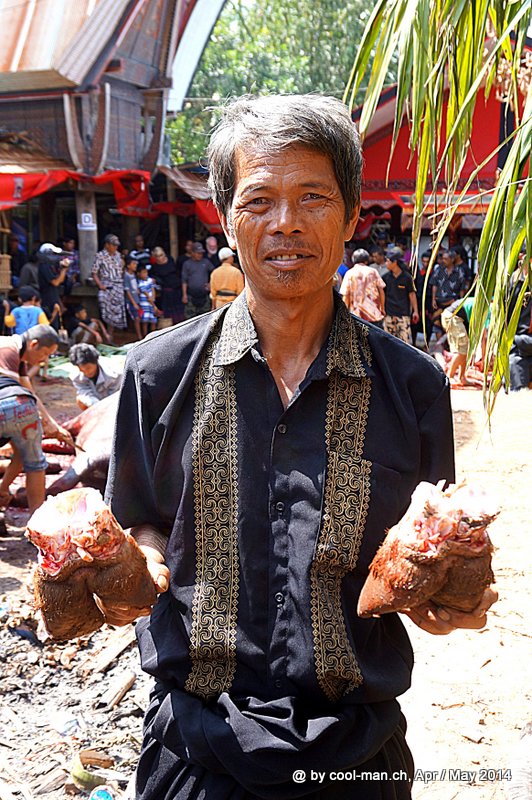
For me, the slaughtering was the most brutal thing I’ve ever seen. In the end my hands trembled. The first buffaloes were tied at the foot to a stake so that they would not run into the spectators in the throes of death. Then the throat of the buffalo was cut with a machete. Immediately blood splashed from the neck area. Each buffalo reacted differently in the death struggle. Some simply stopped until they could no longer stand on their feet, fell to the ground and soon stopped moving. Others, who were not tied before the deathblow, were still running around the area. Twice I had to run to safety. On such occasions people have been killed by buffaloes. A buffalo already lying on the ground kept lifting its head and showing its deep cut on its neck. In the end, all the buffalos were motionless. While the buffaloes died without a sound, the pigs screamed terribly. It was a horrible sight to see all the dead animals. The butchers immediately started to peel off the skin and dismantle the animals. I was thinking whether I should show the terrible pictures in the travel report. In the end I decided to do so because they represent an important part of the Torajan culture. For these people, death is not a reason for mourning, but merely a transition to another stage in the existence of a living being.
The next two days I rented a mountain bike and drove to especially beautiful Toraja villages.
Ke’te Kesu
The most beautiful Toraja village is Ke’te Kesu.
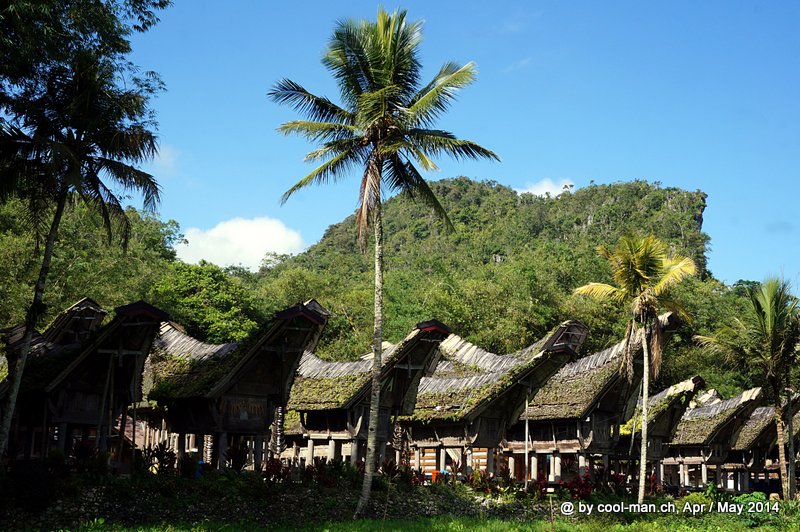
The burial place of Ke’te Kesu
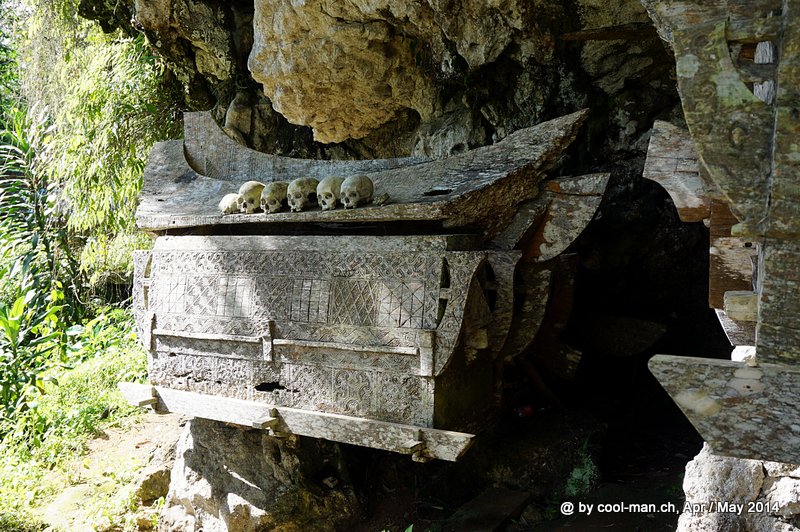
In some villages the dead are buried in caves, where skulls and ancient coffins could be seen. Others carve dolls for the deceased of noble origin that resemble the dead and place these dolls in caves or rocky outcrops to guard the graves and protect the descendants.
A burial site near the Barindi Cave
The cemetery at the entrance to the Barindi cave

The burial place near the village of Lemo
Carved wooden figures, carved in the likeness of the dead, watch over the village of Lemo.
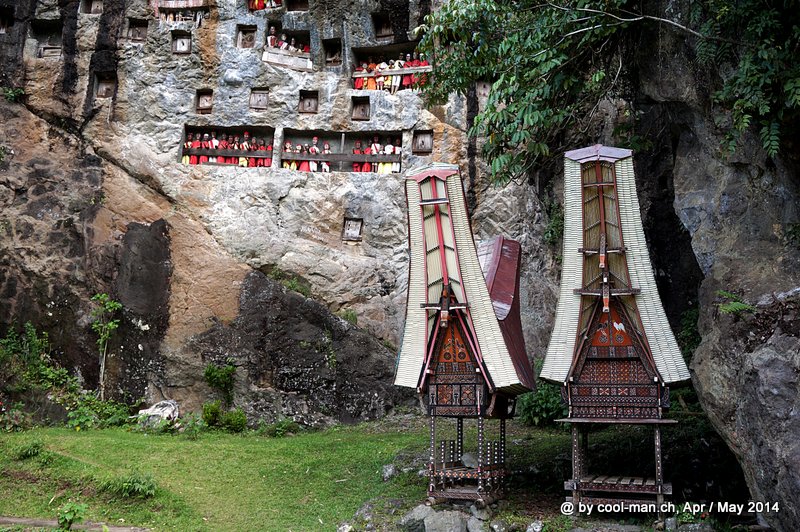
Afterwards I made my way to the remote Togean Islands. It took me three days by bus and boat to get there.
Tentena
On the way I made a stop in Tentena. One of the attractions was the market where dead bats were sold. With their mouths wide open, they looked frightening and disgusting.
Bats that have their wings cut off are sold at the Tentena market.
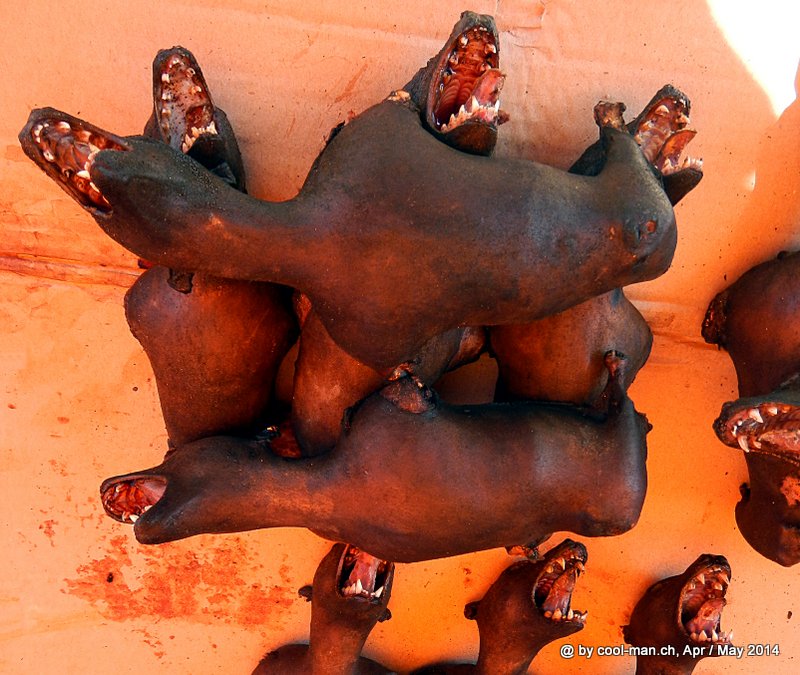
The other attractions were the visit of an impressive waterfall and a beach at the nearby lake. Surprisingly, in the evening I was invited by my motorcyclist to the wedding of his cousin. As usual in Indonesia several hundred guests took part.
Togean Islands
I spent a week in the Togean Islands. The islands are so remote that there is no mobile phone reception and no internet. That is why it was not possible to book in advance. The resorts are all very simple and the food is included in the price as there is no possibility to eat in another place. In my resort Poyalisa there were bungalows in three categories. The simplest ones were the bungalows with separate bathrooms, then those with integrated bathrooms and finally those with integrated bathrooms and views. Since the best category was only four US Dollars more expensive than the easiest one, everyone wanted to live in this category. The newcomers first had to accept the simplest bungalows. Since the people stayed relatively long, one had to wait up to one week, until one could change into the highest category. People who left earlier didn’t stand a chance of getting the best bungalows.
The corals and fish are the attraction of the Togean Islands. In fact, I found a lot of coral reefs here.
A very small part of the underwater world around the Togean Islands
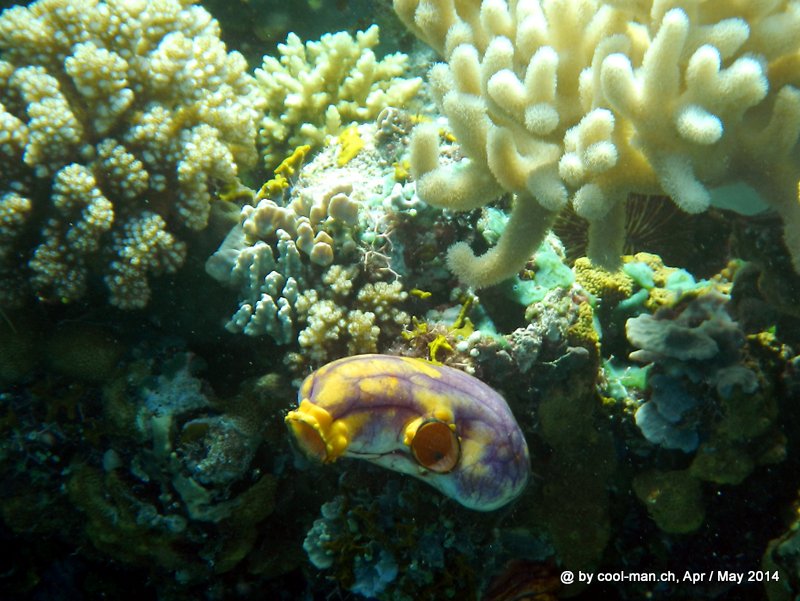
A Freckled Hawkfish
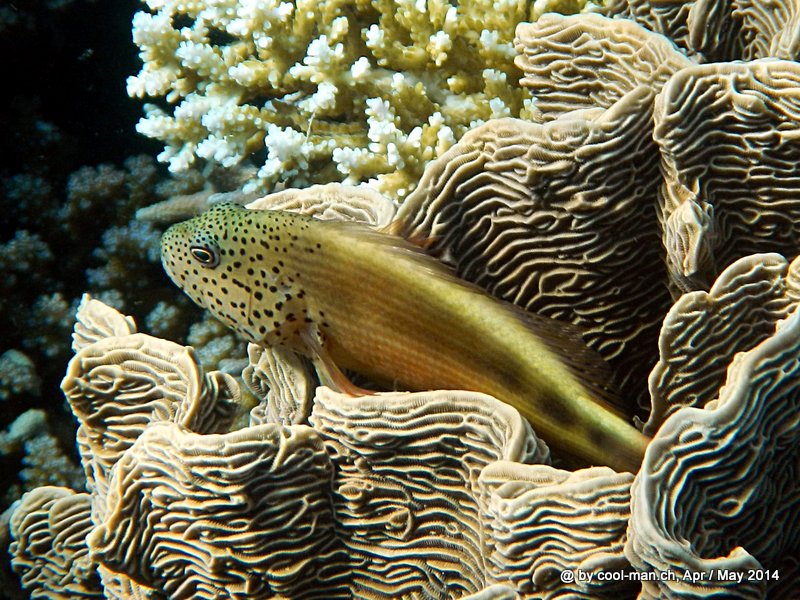
Untouched corals
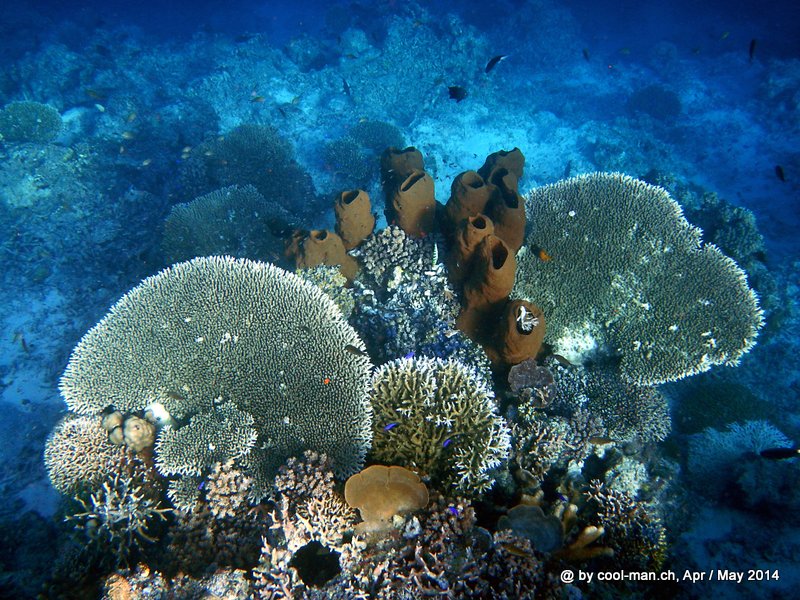
After a week I left the islands for Manado, Sulawesi’s second largest city. The four of us wanted to reach the northern Sulawesi mainland by ferry from Wakai, the capital of the Togean Islands. From the resort we traveled by boat to Wakai, two hours away, but there was no ferry in the harbour. The ferry had technical problems and could not leave. Although we had reserved a cabin, it was not possible to inform us about this change without mobile phone reception. In Wakai we were told that we could charter a speedboat to take us to a city south of the Togean Islands on the Sulawesi mainland. From there we would have to take a car to a city two hours away where another ferry would leave for our destination. Due to a lack of alternatives we accepted this offer. Sweaty and tired we reached the ferry in time in the evening, but there were no cabins on this ferry. My three fellow passengers were ready to spend the night for twelve hours on the ferry’s dirty, hard floor. Then it was another twelve hours bus ride to Manado. Since I knew that there was an airport in a city three hours away and an airplane flew to Manado the next day, I decided for the flight. Soon I was in the hotel room and enjoyed the refreshing shower.
The next day I made my way to the airport early. Arrived there I was relieved that I could buy a ticket for my flight. After one hour flying time we arrived in Manado with a small propeller plane. I spent one day in the city and the next day I traveled on to the nearby island of Bunaken.
Bunaken
The strong water currents around the island of Bunaken hold the numerous nutrients together in a huge vortex. This special combination is responsible for the extremely large coral and fish diversity, which is hardly surpassed by any other place in the world. The island is therefore well known among divers. But also I as a snorkeler got my money’s worth. Right in front of my resort was the most interesting reef I have ever seen. Because of the strong currents I had to stop exploring the reef a few times.
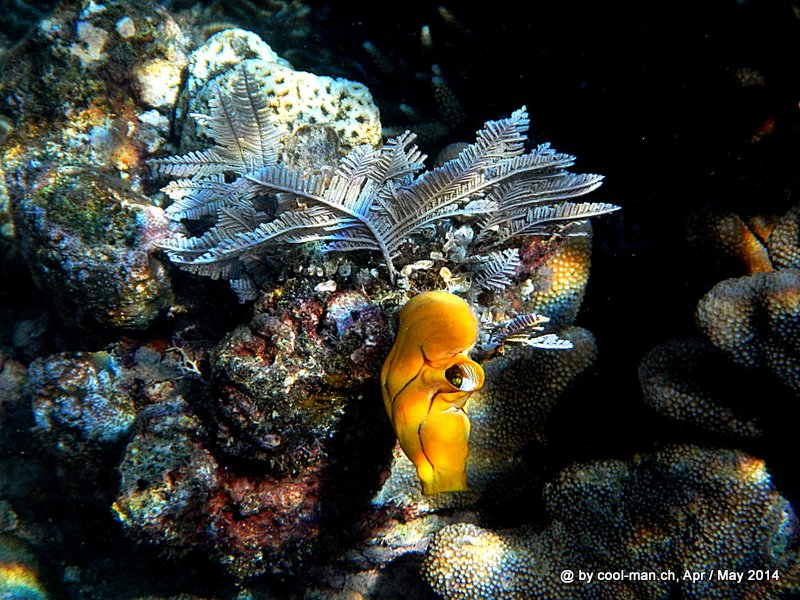
Horned Sea Stars

A Honeycomb Grouper
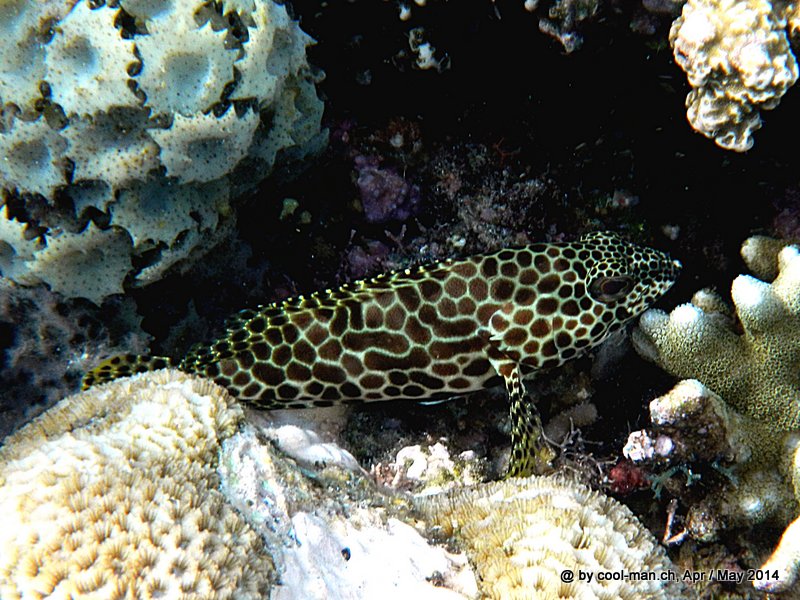
I could not identify this wrasse species.

All in all, I liked it very much in Indonesia. The people are friendly and helpful. As a western foreigner you have a very high status. I was asked again and again whether I could pose with locals for photos. Invitations to private houses can be accepted almost without hesitation, because it is an honor for the family if a westerner visits the house. Unfortunately, this is not possible without danger in all countries.
There are hardly any fixed prices in Indonesia. Those who do not negotiate here often pay double or even more. I was even able to haggle down the excess baggage costs at the airport.
It is a pity that Indonesia’s rainy season falls on the European winter. The exceptions are the Moluccas and the island of Papua. Maybe I will visit these areas next winter.
All in all my seven-month journey to the Philippines, Nepal, Thailand, Malaysia, Brunei and Indonesia ended without any unpleasant incidents. It is amazing how quickly time passes. It never got boring for me. Now I’m looking forward to the Swiss summer.
This text is an automatic English translation from the German original by deepl.com